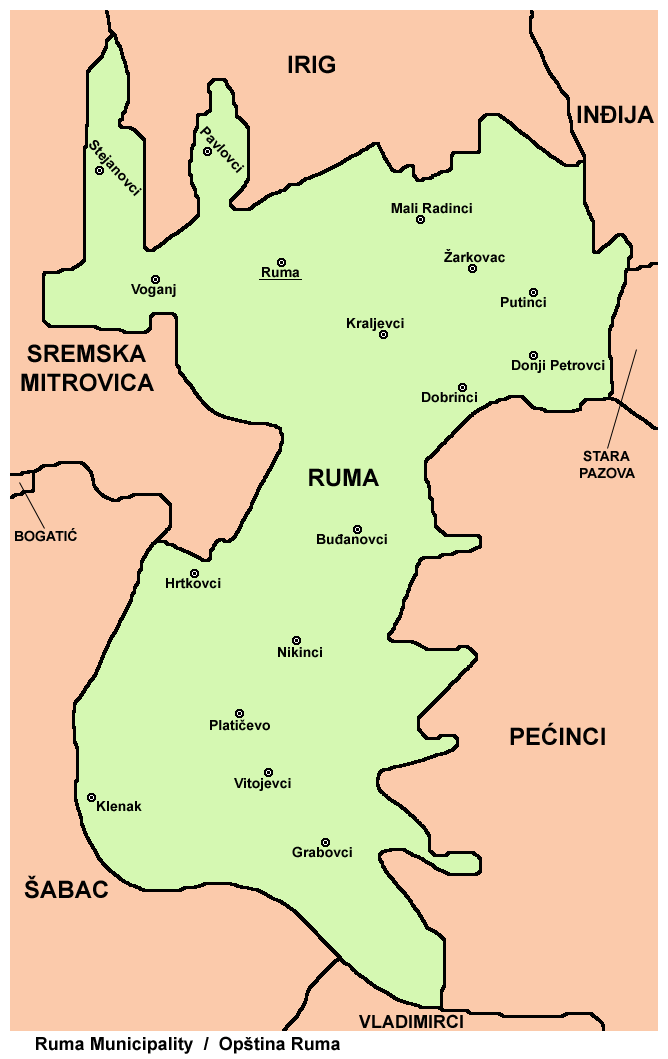|
Voganj
Voganj () is a village in Serbia. It is situated in the Ruma municipality, in the Srem District, Vojvodina province. The village has the population of 1,506 (2011 census). Location The village is located west of its municipal seat, town of Ruma. It is stretched along both sides of the Ruma-Sremska Mitrovica road, which southwest of the village crosses both the railway and highway Belgrade-Zagreb. It functions as an adjoining suburb of Ruma as it almost makes one continuously built-up area with it. Geography Voganj is a rural settlement of the semi-compact type. It is located on the loess plateau at an altitude of . It covers an area of and statistically consists of two cadastre municipalities: Voganj () and Marđelos (). It is a typical road settlement, stretched along the road. It consists of two parts: much larger Voganj (simply referred to as ''Selo'', village) and smaller and separated Erem. East of the village flows the river Kudoš, separating Voganj and Ruma, wh ... [...More Info...] [...Related Items...] OR: [Wikipedia] [Google] [Baidu] |
Voganj Railway Station
Voganj railway station () is a railway station on Belgrade–Šid railway. Located in Voganj, Ruma, Serbia. Railroad continued to Sremska Mitrovica in one and the other direction to Ruma. Voganj railway station consists of 5 railway track. See also * Serbian Railways Serbian Railways ( sr-Cyrl-Latn, Железнице Србије, Železnice Srbije, separator=" / "; abbr. / ) is a Serbian engineering and technical consulting company based in Belgrade, Serbia. In 2015, the Government of Serbia establishe ... References Ruma Railway stations in Vojvodina {{Europe-railstation-stub ... [...More Info...] [...Related Items...] OR: [Wikipedia] [Google] [Baidu] |
Ruma
Ruma (; ) is a town and municipality in the Srem District of the Autonomous Province of Vojvodina, Serbia. As of 2022, the town has a population of 27,747, while the municipality has a population of 48,621. History Traces of organized human life on the territory of Ruma municipality date back as far as prehistory. The most important archaeological locality in the municipality is Bronze Age Gomolava near Hrtkovci, with two exclusive tombs of Bosut culture dating to the 9th century BC and 3000BC Vučedol culture pottery. The first known inhabitants of this area were various peoples of Illyrians, Illyrian and Celts, Celtic origin, such as the Amantini, Breuci, Scordisci, etc. During the Roman Empire, Roman rule, local inhabitants lost their ethnic character and adopted Roman culture. There were no larger Roman settlements on the territory of Ruma, but a certain number of agricultural estates known as "Roman villa, villae rusticae" were located there. Migrations of Huns, Germanic peo ... [...More Info...] [...Related Items...] OR: [Wikipedia] [Google] [Baidu] |
List Of Populated Places In Serbia
This is the list of populated places in Serbia (excluding Kosovo), as recorded by the Demographics of Serbia, 2002 census, sorted alphabetically by Municipalities of Serbia, municipalities. Human settlement, Settlements denoted as "Urban area, urban" (towns and city, cities) are marked bold. Population for every settlement is given in brackets. The same list in alphabetic order is in List of populated places in Serbia (alphabetic). A Ada (Serbia), Ada Aleksandrovac Aleksinac Alibunar Apatin Aranđelovac Arilje B Babušnica Bač, Serbia, Bač Bačka Palanka Bačka Topola Bački Petrovac Bajina Bašta Barajevo Batočina Bečej Bela Crkva (Vojvodina), Bela Crkva Bela Palanka Beočin Blace Bogatić Bojnik Boljevac Bor (Serbia), Bor Bosilegrad Brus Bujanovac C Crna Trava Č Čačak Čajetina Čoka Čukarica Ć Ćićevac Ćuprija D Despotovac Dimitrovgrad (Serbia), Dimitrovgrad Doljevac G Gadžin Han Golubac ... [...More Info...] [...Related Items...] OR: [Wikipedia] [Google] [Baidu] |
Syrmia
Syrmia (Ekavian sh-Latn-Cyrl, Srem, Срем, separator=" / " or Ijekavian sh-Latn-Cyrl, Srijem, Сријем, label=none, separator=" / ") is a region of the southern Pannonian Plain, which lies between the Danube and Sava rivers. It is divided between Serbia and Croatia. Most of the region is flat, with the exception of the low Fruška gora mountain stretching along the Danube in its northern part. Etymology The word "Syrmia" is derived from the ancient city of Sirmium (now Sremska Mitrovica). Sirmium was a Celts, Celtic or Illyrians, Illyrian town founded in the third century BC. ''Srem'' ( sr-Cyrl, Срем) and ''Srijem'' ( sr-Cyrl, Сријем, label=none) are used to designate the region in Serbia and Croatia respectively. Other names for the region include: * Latin: ''Syrmia'' or ''Sirmium'' * Hungarian language, Hungarian: ''Szerémség'', ''Szerém'', or ''Szerémország'' * German language, German: ''Syrmien'' * Slovak language, Slovak: ''Sriem'' * Pannonian R ... [...More Info...] [...Related Items...] OR: [Wikipedia] [Google] [Baidu] |
Sava
The Sava, is a river in Central Europe, Central and Southeast Europe, a right-bank and the longest tributary of the Danube. From its source in Slovenia it flows through Croatia and along its border with Bosnia and Herzegovina, and finally reaches Serbia, feeding into the Danube in its capital, Belgrade. The Sava is long, including the Sava Dolinka headwater rising in Zelenci, Slovenia. It is the largest List of tributaries of the Danube, tributary of the Danube by volume of water, and the second-largest after the Tisza in terms of catchment area () and length. It drains a significant portion of the Dinaric Alps region, through the major tributaries of Drina, Bosna (river), Bosna, Kupa, Una (Sava), Una, Vrbas (river), Vrbas, Lonja, Kolubara, Bosut (river), Bosut and Krka (Sava), Krka. The Sava is one of the longest rivers in Europe and among the longest tributaries of another river. The population in the Sava River basin is estimated at 8,176,000, and is shared by three capit ... [...More Info...] [...Related Items...] OR: [Wikipedia] [Google] [Baidu] |
Translation Of The Relics Of Saint Nicholas From Myra To Bari
The Translation of the Relics of Saint Nicholas from Myra to Bari is a religious and folk holiday among the East Slavs and, to a lesser extent, the South Slavs and Eastern Romance peoples. It is celebrated on May 9 each year. For Old (Julian) Calendar churches, May 9 falls on May 22 of the New (Gregorian) Calendar. The feast commemorates the translation (movement) of the relics of Saint Nicholas from Myra (in present-day Turkey) to Bari, on the Italian Peninsula. To this day, the relics remain at the Basilica of Saint Nicholas. One story of the translation In 1087, nobles and merchants of Bari, Italy, visited the relics of Saint Nicholas in 1087 after finding out their resting-place from the monks who guarded them. According to one account, the monks showed the resting-place but then became immediately suspicious: "Why you men, do you make such a request? You haven't planned to carry off the remains of the holy saint from here? You don't intend to remove it to your own r ... [...More Info...] [...Related Items...] OR: [Wikipedia] [Google] [Baidu] |
Hermit
A hermit, also known as an eremite (adjectival form: hermitic or eremitic) or solitary, is a person who lives in seclusion. Eremitism plays a role in a variety of religions. Description In Christianity, the term was originally applied to a Christian who lives the eremitic life out of a religious conviction, namely the Catholic spirituality#Desert spirituality, Desert Theology of the Old Testament (i.e., the 40 years wandering in the Zin Desert, desert that was meant to bring about a change of heart). In the Christian tradition the eremitic life is an early form of Monk, monastic living that preceded the monastic life in the cenobium. In chapter 1, the Rule of St Benedict lists hermits among four kinds of monks. In the Roman Catholic Church, in addition to hermits who are members of religious institutes, the Canon law (Catholic Church), Canon law (canon 603) recognizes also Consecrated life#Other forms of consecrated life, diocesan hermits under the direction of their diocesan b ... [...More Info...] [...Related Items...] OR: [Wikipedia] [Google] [Baidu] |
Politika
( sr-Cyrl, Политика, lit=Politics) is a Serbian daily newspaper, published in Belgrade. Founded in 1904 by Vladislav F. Ribnikar, it is the oldest daily newspaper still in circulation in the Balkans. Publishing and ownership is published by Politika novine i magazini (PNM), a joint venture between Politika a.d. and East Media Group. The current director of PNM is Mira Glišić Simić. PNM also publishes: *''Sportski žurnal'' *''Politikin Zabavnik'' *''Svet kompjutera'' *''Ilustrovana Politika'' *''Bazar'' History Since its launch in January 1904, was published daily, except for several periods: *Due to World War I, there were no issues from 14 November 1914 to 21 December 1914, and again from 23 September 1915 to 1 December 1919. *Due to World War II, there were no issues from 6 April 1941 to 28 October 1944. *In protest against the government's intentions to turn into a state-owned enterprise, a single issue was not published in the summer of 1992. The launc ... [...More Info...] [...Related Items...] OR: [Wikipedia] [Google] [Baidu] |
Croatia
Croatia, officially the Republic of Croatia, is a country in Central Europe, Central and Southeast Europe, on the coast of the Adriatic Sea. It borders Slovenia to the northwest, Hungary to the northeast, Serbia to the east, Bosnia and Herzegovina and Montenegro to the southeast, and shares a maritime border with Italy to the west. Its capital and largest city, Zagreb, forms one of the country's Administrative divisions of Croatia, primary subdivisions, with Counties of Croatia, twenty counties. Other major urban centers include Split, Croatia, Split, Rijeka and Osijek. The country spans , and has a population of nearly 3.9 million. The Croats arrived in modern-day Croatia, then part of Illyria, Roman Illyria, in the late 6th century. By the 7th century, they had organized the territory into Duchy of Croatia, two duchies. Croatia was first internationally recognized as independent on 7 June 879 during the reign of Duke Branimir of Croatia, Branimir. Tomislav of Croatia, Tomis ... [...More Info...] [...Related Items...] OR: [Wikipedia] [Google] [Baidu] |
Kordun
The Kordun () region is a part of central Croatia from the bottom of the Petrova Gora (Peter's mountain) mountain range, which extends along the rivers Korana and Slunjčica, and forms part of the border region to Bosnia and Herzegovina. Within Croatia, Kordun is bordered by the Lika region to the south and by Banovina or Banija to the east. Most of Kordun with its centre Slunj belongs to Karlovac County (Slunj, Cetingrad, Krnjak, Rakovica and Vojnić). Vrginmost belongs to Sisak-Moslavina County. In former times, this region belonged to the Habsburg Military Frontier towards the Ottoman Empire which is more or less exactly the same today which the border of Croatia and Bosnia. Following the Croatian War of Independence, a number of towns and municipalities in the region were designated Areas of Special State Concern. The area has rich wood resources. Today, the economic situation is slowly improving, but there is still a large tendency of emigration from the region to la ... [...More Info...] [...Related Items...] OR: [Wikipedia] [Google] [Baidu] |



